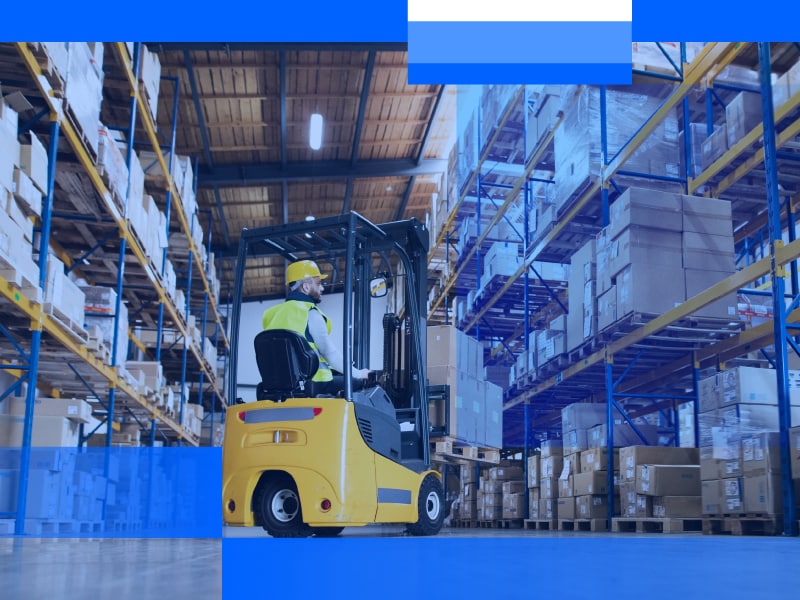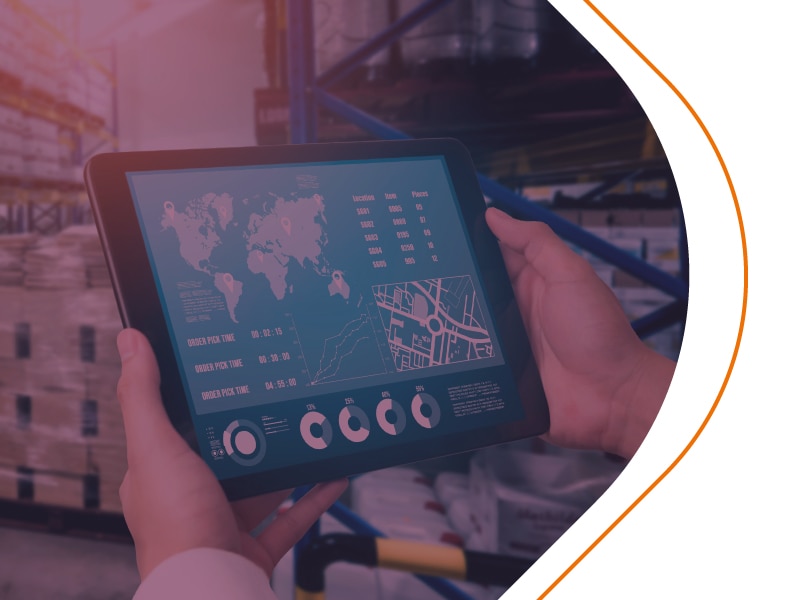Home > TradeEdge > Blogs > AI in supply chains – Unlocking the potential of an omnichannel ecosystem
AI in supply chains – Unlocking the potential of an omnichannel ecosystem

Table of Contents
The challenges in supply chain seem endless ever since the pandemic; with its rippling effect felt far and deep into the network. The changing geo-political situations, inflation, general economic meltdown, and natural disasters striking countries worldwide are key disruptors, causing labor and material shortages, equipment unavailability, and elevated freight rates.
According to experts, supply chain problems would continue for another year or two. Granular visibility in the network is one of the primary ways to help companies stay prepared for any upcoming disruption. Digital solutions powered by AI and Automation are harnessed by organizations to collect, analyze, and interpret high-quality, up-to-the-minute data and gain end-to-end visibility into their value network. Also, an omnichannel supply chain strategy supports a customer-centric network, end-to-end planning and information flow, connected operation, and a transparent distribution system. An omnichannel model keeps organizations ahead of the market challenges while delivering consistent and seamless services to meet customer demand. It eliminates siloes and provides a ground-level view of sales and distribution channels – essentials for success in the competitive market.
What does an omnichannel supply chain mean?
An omnichannel chain is a multichannel supply chain that uses different channels to serve customers for a superior experience. It merges several sales, warehousing, and other operating systems into a single, one-touch integration, collectively catering to online and in-store requirements. Typically, a retail store/boutique can sell goods through e-stores, in-person, and social media platforms like Instagram.
An omnichannel supply chain ecosystem can win if there is an end-to-end collaboration among all stakeholders, suppliers, and customers. And companies can conveniently meet changing customer requirements only when adequate information is shared along the entire value network.
However, migrating the entire network operations on a unified platform is much more complicated than it sounds:
Omnichannel supply chain solutions – Things to know
The journey from traditional brick-and-mortar store selling to a hybrid physical and virtual store selling model has been challenging for businesses. The primary challenge arose from the need to satisfy two different markets with multiple and sometimes conflicting requirements. A poor understanding of the new model would only add to their list of troubles. Therefore, complete knowledge of a few important facts related to omnichannel supply chains will make the transition easy and seamless.
Omni vs. Multichannel – Are they synonymous?
Multichannel and omnichannel are similar terms often used interchangeably but are different. Multichannel means leveraging multiple supply chains to satisfy unique shopping experiences, where each channel is separate and distinct. There are unique online catalogs and pricing. And each store operates as a separate entity. Contrarily, omnichannel supply chains usually operate with a single network. The online catalog and its prices are similar to physical stores and share information about online stock levels and stocks in nearby stores. It allows customers to visit stores and checkout items, but they can purchase online.
Simple migration – Or complete revamp?
An omni channel supply chain should be flexible to allow the supply of bulk orders to stores and individual items to online customers. Therefore, restructuring the entire network is needed to support important decisions regarding inventory storage, processing, and shipping orders. An omnichannel operation works with multiple regional distribution centers and often relies on third-party distributors.
Omnichannel means an integrated system
An omni channel supply chain will not perform in the absence of an integrated software platform. It requires every network element to be connected, including other operating areas such as marketing, sales, procurement, and logistics. Omnichannel supply chain solutions support complete network visibility, enhance forecast capabilities, accommodate adequate inventory planning and order management, and allow owners to adopt fast stock replenishment strategies.
Say goodbye to siloes
In order to support the objectives mentioned above, functional siloes need to be broken down. And an omnichannel setup does exactly that. It eliminates any possibilities of division in functions or individuals controlling the supply of information, materials, or sales. It paves the way for a transparent supply chain ecosystem, allowing customers the freedom and flexibility to browse online, visit local stores, and place orders when and where they want. With unhindered sharing of information, network agility and responsiveness improved.
Increased customer expectations
An omnichannel supply chain increases the ability to initiate purchasing process from a mobile platform, continue using a browser, and complete the payment in a physical store. Furthermore, customers can easily return items purchased online to the nearest store and receive a refund immediately. This fosters customer loyalty by providing a pleasant, convenient, and stress-free buying experience.
The role of AI in omnichannel supply chains
A gradual shift in shopping preference from physical outlets to e-commerce was already underway, which doubled in the last couple of years. Initially, many ventures were reluctant or slowed in adopting the transition. However, they are stepping up their technology investments to meet the needs of their buyers. Apart from solidifying their online presence, they are focusing on strengthening the value network to provide a convenient shopping experience. Hence, technologies like AI and automation are increasingly leveraged to enable a complete migration of operations without disrupting the general flow of goods and sales.
Here, an omnichannel supply chain plays a critical role, providing the stakeholders with much-needed visibility into what is happening at the supplier/distributor end and how they can keep up with the sudden rise in customer demand. And AI plays its part by breaking the data siloes and capturing ground insights in real-time, so suppliers, owners, and distributors are always ready with their contingencies regardless of changes in demand, sudden price spikes in transportation, accidental blockage in distribution, and shortage of labor. Multi-enterprise visibility into each source gives more control to businesses and assists them in adequate inventory management and curbing lead times. The primary objective of an AI-enabled omnichannel supply chain for e-commerce is to improve customer journeys. So, all the efforts to improve the entire demand-value network are directed towards ensuring customers get what they want (in terms of quantity, price, and quality), where they want, and when.
Download our whitepaper: https://www.edgeverve.com/tradeedge/supply-chain-transformation-with-business-network/?src_page=109182
Benefits of AI in supply chain operations
Primary AI applications in omnichannel supply chains
To support the omnichannel experience in a supply chain ecosystem, AI and related capabilities drive strategic improvements at key processes in operation. The following is a list of applications exemplifying AI’s contribution to changing the entire value network for businesses:
AI-enabled demand forecasting
Forecasting and planning stocks for matching demand have become more intricate in the post-pandemic era. Disruptions arising from time to time at different areas in the network also shifted sourcing locations closer to where the manufacturing units are. Customers, too, are exhibiting other buying behaviors, focusing more on local, sustainable produce and conscious purchase. Therefore, anticipating long-term demand has taken a back step. Instead, companies are redirecting their efforts to capture early demand signals in the short term. An omnichannel supply chain supported by AI technology enables owners to understand precisely what is happening in the market (at various locations), what customers prefer more, and where they are procuring their goods/services from earlier. Furthermore, big brands are challenged by local sellers because customers have shifted their preferences to cost-effective local purchases. Therefore, AI-demand forecasting is leveraged as the best bet to stay ahead of the market and competition simultaneously.
AI-enabled inventory management
The empty shelves due to the pandemic exposed incompetent demand forecasting, planning, and inventory management methods. One of the major causes would be poor visibility into what was happening at the supplier’s end. Omnichannel supply chain solutions supported by AI capability enable businesses to anticipate market demand and correctly prepare inventories accordingly. Stock-out or overstock situations are duly avoided, saving dollars in storage costs, and averting expensive losses due to damage or wastage of excess inventories. E-commerce and retailers are best benefitted since their shelves need to be stocked up to retain customers while ensuring perishable items don’t run out of shelf life before they are sold out.
AI-enabled logistics management
Labor shortages and exorbitant freight charges added to the high price customers had to bear to get their daily essentials delivered to their doorstep. In addition, the Suez Canal blockage disrupted the entire distribution network, eventually delaying services and deliveries. This eye-opening event, however, proved a catalyst for innovative technologies to find their firm footing here. For instance, AI-powered routing in omnichannel supply chain solutions enables owners to extract insights from various data sources and plan alternate travel routes. This allows goods to be transported from another route when the original is clogged with traffic.
AI-enabled customer experience
Here, numerous datasets and tech-enabled solutions make it possible to understand who customers are and what they intend to do. Therefore, enterprises can uncover ways and optimize their supply chains with omnichannel capabilities to serve them better by doing everything near real-time.
Roadblocks in omnichannel supply chain – AI-related challenges and remedies
Data restrictions: Obviously, these constraints exist to prevent information leakage. However, the same restrictions can prevent the proper functioning of an AI-powered omnichannel model. Minimizing restrictions allows easy real-time data integration into processes and systems while allowing digital business networks to maintain ‘single versions of the truth’ so operations can occur using the most available information.
Disconnected system: Fragmented systems are a significant challenge in any company. Technology can vary locally and globally within the same company and between partners. Therefore, a proper framework and adequate infrastructure should be constructed uniformly across the company and its locations before considering implementation.
Operational costs: At times, introducing an intelligent software system can sometimes exceed the allocated budget. However, this is a one-time investment. So accurate implementation and maintenance will guarantee higher returns. Furthermore, when sourcing AI software solutions from third-party vendors, the market is spoiled for choices. Hence, finding a vendor within your budget is possible, offering a customized solution that aligns with your business objectives.
The final takeaway
The primary objective of the omnichannel approach is to offer customers a superior shopping experience matching their time, quality, quantity, price, and convenience preferences. And that requires migrating the value network and its operations to a unified platform for end-to-end visibility. Hence, the concept of building an omnichannel supply chain is gaining importance presently. After all, the market we knew no longer exists now, and customers have changed their buying decisions to sustain the tumultuous post-pandemic era. Therefore, when the market and buyers are changing, businesses must adapt fast and stay available exactly where customers are and when. This is the key to staying ahead and competitive in a saturated ecosystem.


Possibilities Unlimited
Possibilities Unlimited
Inspiring enterprises with the power of digital platforms
More blogs from EdgeVerve →